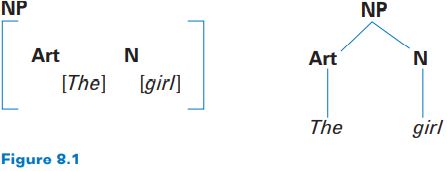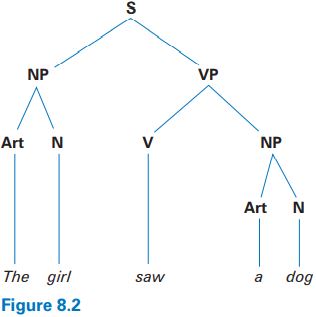
Tree diagrams
 المؤلف:
George Yule
المؤلف:
George Yule
 المصدر:
The study of language
المصدر:
The study of language
 الجزء والصفحة:
99-8
الجزء والصفحة:
99-8
 16-2-2022
16-2-2022
 5022
5022
One of the most common ways to create a visual representation of syntactic structure is through tree diagrams. We can use the symbols introduced in Chapter 7 (Art = article, N = noun, NP = noun phrase) to label parts of the tree as we try to capture the hierarchical organization of those parts in the underlying structure of phrases and sentences. So, we can take the information in a labeled and bracketed format, shown on the left, and present it in a tree diagram, shown on the right.
Although this kind of “tree,” with its “branches,” shown on the right, seems to grow down rather than up, it functions rather well as a diagram representing all the grammatical information found in the other analysis on the left. It also shows very explicitly that there are different levels in the analysis. That is, there is a level of analysis at which a constituent such as NP is represented and a different, lower, level at which a constituent such as N is represented. This type of hierarchical organization can be illustrated in a tree diagram for a whole sentence, beginning at the top with S.


If we start at the top of the tree diagram, we begin with a sentence (S) and divide it into two constituents (NP and VP). In turn, the NP constituent is divided into two other constituents (Art and N). Finally, one word is selected that fits the label Art (the) and another that fits N (girl). You can go through the same procedure with the VP branches.
 الاكثر قراءة في Syntax
الاكثر قراءة في Syntax
 اخر الاخبار
اخر الاخبار
اخبار العتبة العباسية المقدسة


